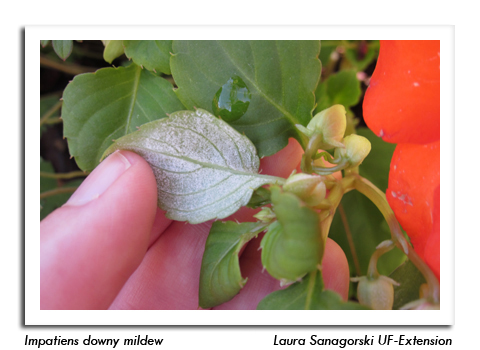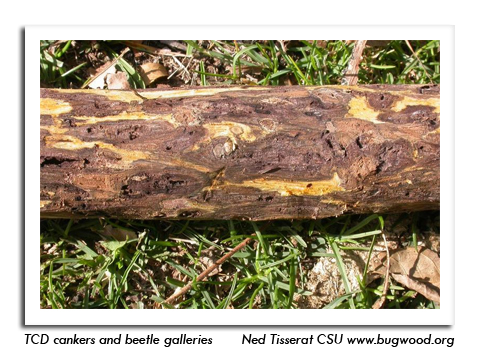
 |
|
|
Nursery & Forest
Volume 62 Number 19 Date 11/09/2017 NURSERY INSPECTION - Nursery Program personnel inspected 427 nursery grower fields in 2017, representing a large percentage of the production of the 632 licensed nursery growers in the state. Staff also conducted nursery dealer inspections at 627 sites selected from Wisconsin's 1,151 licensed nursery dealers. The top 10 insect and plant diseases found this season were, by total number of detections: viruses, leaf spots, powdery mildew, rusts, aphids, Japanese beetle, anthracnose, leafminers, apple scab and necrosis/dieback. Inspectors issued 125 Plant Health Certificates for the out-of-state shipment of nursery stock. SUDDEN OAK DEATH - Twelve rhododendron samples were tested for Phythophthora ramorum, the causal agent of sudden oak death (SOD). All were negative for this regulated disease. Eight of the samples were "trace forwards" from nurseries with confirmed SOD-infested stock. Sudden oak death has to date not been found in Wisconsin. INVASIVE SPECIES RULE - Invasive plants prohibited or restricted in Wisconsin under the Chapter NR 40 Invasive Species Rule were documented by inspectors at 208 nursery locations this season, with 32 activity reports issued for violations. The most frequently intercepted invasives were Japanese barberry, woodland forget-me-not, Amur maple, Bishop's goutweed, burning bush, and ribbon grass. The phase-out period for selling restricted herbaceous plants and woody vines that were added to the list in 2015 will expire on May 1, 2018. BOXWOOD BLIGHT - A major concern to the nursery industry and boxwood growers, this fungal disease was not found in any of the 10 boxwood samples submitted for testing in 2017. The symptoms were instead determined to be caused by either Volutella blight, Fusarium, or Verticillium wilt. Boxwood blight was identified for the first time in the U.S. in 2011, and since then has been found in 18 states, including Illinois and Ohio. -- Liz Meils, DATCP Nursery Inspector IMPATIENS DOWNY MILDEW - Several impatiens plants from a Sheboygan County grower tested positive for impatiens downy mildew (IDM) on May 22. The affected varieties, 'Accent TM Premium Red,' 'Accent TM Premium White,' and 'Double Impatiens Silhouette Salmon,' were promptly removed from sale. The UW Plant Disease Diagnostic Clinic also confirmed one case of IDM from Marinette County in late June. VIRUSES IN ORNAMENTALS - Nursery inspectors submitted a total of 140 annuals and perennials to the Plant Industry Lab for virus testing. The symptomatic plant samples were screened for up to 11 viruses, including two group tests for potyviruses and ilarviruses. Sixty-four percent of the plant samples (90 of 140) tested positive for at least one plant virus. Following potyviruses with 45 positives (41 on iris alone), other common disease-causing viruses were tobacco rattle virus with 13 positives, hosta virus X with 10 positives, viruses in the ilavirus group with seven positives, and cucumber mosaic virus with six positives. The specific potyvirus that infected many of this year's iris samples was iris severe mosaic virus, which is transmitted by probing aphids and mechanical inoculation (i.e., cutting tools). One iris cultivar, 'Mt. Fujiyama,' was infected with the tospovirus impatiens necrotic spot virus. Greenhouse producers, nurseries and retailers cooperated with inspectors by removing all infected plant material from sale. -- Anette Phibbs, DATCP Plant Pathologist WALNUT TWIG BEETLE - A trapping survey was conducted in 17 counties to detect to the walnut twig beetle component of thousand cankers disease (TCD). Survey locations were within the natural range of eastern black walnut in southern and western Wisconsin and included brush disposal sites and sawmills receiving black walnut logs from TCD-infested states. Twenty-one baited Lindgren funnel traps were set in Buffalo, Chippewa, Crawford, Dane, Dunn, Fond du Lac, Grant, Green Lake, Iowa, La Crosse, Lafayette, Pepin, Richland, Rock, Sauk, Trempealeau and Vernon counties, with no beetles found in the collection samples processed as of November 9. DATCP has conducted walnut twig beetle surveys for the last six years. EMERALD ASH BORER - An additional 117 EAB finds were confirmed this season, for a cumulative total of 391 municipal detections in 47 counties since 2008. Most were near known infested areas in the southern half of the state where EAB is already well established, although isolated infestations were also identified in northern Wisconsin. The cooperative EAB trapping survey conducted by state, federal, county and tribal partners consisted of 1,434 traps set primarily in the northern counties. Beetles were captured on survey traps in Green Lake, Marinette, Waushara and Waupaca counties for the first time, and EAB-infested trees were found in Chippewa, Iowa and Marathon counties this season, prompting an expansion of the state EAB quarantine to include these six counties (Iowa County was quarantined in 2014 without an EAB detection). A map showing the 391 cities, villages, and townships with confirmed EAB finds, as well as the state's 48-county quarantine, is provided below. Most of Wisconsin remains uninfested, including much of the northern half and the gray areas in all quarantined counties. AMBROSIA BEETLE - The exotic ambrosia beetle Anisandrus maiche was collected in July from honey locust saplings at an Ozaukee County nursery, representing the first Wisconsin detection of this species. Protruding frass toothpicks along the main plant stem provided evidence of the infestation. Two other significant pests, the black stem borer, Xylosandrus germanus, and nectria canker, were also found in association with the infested honey locusts. VELVET LONGHORNED BEETLE - DATCP and the USDA APHIS confirmed the first detection of velvet longhorned beetle (VLB) in Wisconsin on July 13, in two Milwaukee County survey traps. The beetle had previously been intercepted last year in rustic hickory-style log furniture manufactured in China, but never found in the Wisconsin landscape. Velvet longhorned beetle infests a wide range of forest, orchard and urban trees and may have the potential to become a pest in the state. The specimens were collected as part of the national survey program for exotic woodborers and bark beetles. Seventy-seven other traps set at 32 municipal brush drop-off sites and commercial port locations in Brown, Dane, Douglas, Eau Claire, Fond du Lac, Kenosha, Manitowoc, Marinette, Milwaukee, Ozaukee, Racine, Sauk, Sheboygan and Waukesha counties were negative for 10 target beetle species. -- Renee Pinski, DATCP Forest Entomologist GYPSY MOTH - Moth counts increased by 20% in 2017. The state trapping program recorded a total capture of 108,008 male moths in 10,878 traps. Another 1,329 moths were collected in traps set at the Ports of Green Bay, Marinette and Milwaukee, for an official total of 109,333 gypsy moths caught in the state this year. Program coordinators attribute the higher trap counts to increasing populations over much of eastern and central Wisconsin which are generally infested. By contrast, counts in the still largely uninfested western counties were at or below last year's totals. The season's highest counts were in Bayfield (14,354 moths), Monroe (9,989 moths), Sauk (9,561 moths), and Juneau counties (9,109 moths). No surveyed county reported zero moths. The DATCP Slow the Spread Program treated a total of 154,508 acres at 51 sites in 18 counties from May 15-July 17 in western Wisconsin. Btk was applied to 22,792 acres and mating disruption covered 131,716 acres. The DNR Suppression Program also treated five sites with Btk totaling 434 acres in Dane and Sauk counties. There were no eradication sites or NPV treatments this year, and no new counties were added to the 50-county Wisconsin Gypsy Moth Quarantine. -- Chris Whitney, DATCP Gypsy Moth Trapping Coordinator 





|
|
|